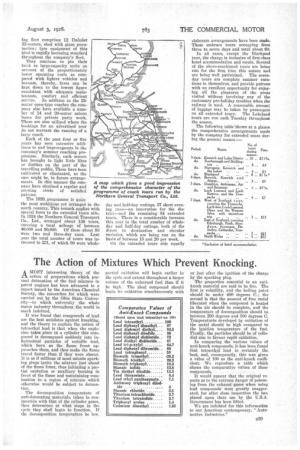The Action of Mixtures Which Prevent Knocking.
Page 23

If you've noticed an error in this article please click here to report it so we can fix it.
AMOST interesting theory of the action of preparations which prevent detonation of the fuel mixtUre in petrol engines has been advanced in a report issued by the American Chemical Society, the researches for which were carried out by the Ohio State University—to which university the whole motor industry throughout the world is much indebted.
It was found that compounds of lead are the best antidotes against knocking, and the theory to explain the action of tetraethyl lead is that when the explosion takes place in a cylinder this coinPound is decomposed suddenly into infinitesimal particles of metallic lead, which burn as the flame front approaches them, and thus make the flame • travel faSter than if they were absent. It is as if millions of most minute sparking plugs ignite the mixture just ahead of the flame 'front, thus initiating a partial oxidation or auxiliary burning in front of the flame and maintaining combustion in a region of mixture which otherwise would be subject to detonation.
The decomposition temperature of anti-detonating materials, taken in conjunction with that of the cylinder gases, thus determines at what stage in the cycle they shall begin to function. If the decomposition temperature be low, partial oxidation will begin earlier in the cycle and extend throughout a larger volume of the unburned fuel than if it be high. The ideal compound should begin its oxidation simultaneously with
or just after the ignition of the charge by the sparking plug.
The properties essential to an antiknock material are said to be five. The first is volatility, and the boiling point should be under 400 degrees C.; the second is that the amount of free metal liberated when the compound is heated in the 'air should be complete, and the temperature of decomposition should be between 200 degrees and 300 degrees C. Temperatures developed by oxidation of the metal should be high compared to the ignition temperature of the fuel. Finally, the particles should be of collodial size to favour rapid oxidation.
In comparing the various values of anti-knock compounds, it has been found that tetraetbyl lead is certainly the. 'best, and, consequently, this was, giyen a value of 100 as the anti-knock coefficient. -We reproduce a table which shows the comparative values of these comPetiuds. It would appear that the original reports as to the extreme danger of poisoning from the exhaust gases when using lead compounds' were greatly exaggerated, for after close inspection the ban placed upon their, use by the U.S.A. Government has been lifted.
We are indebted for this information to our American contemporary, "Automotive Industries."






























